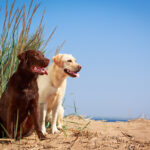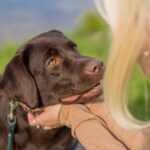by Paula Piatt
They’re laughing at us, you know.
In between all that barking and growling and huffing and puffing, there’s a series of syncopated breaths. Some short, some loud, some long, and some soft. But dig around in the waveforms and the spectrograms of the sounds our canine companions make when they are having fun, and you’ll find it.
Doggie laughter.
“The majority of the target vocalization was happening during play,” said Shelly Volsche of the breathy enthusiasm. The Midwest researcher, along with her team, has completed the first study to confirm a decades-old hypothesis. “This work is the first known study to confirm (Patricia Simonet’s) findings of a domain-specific play pant in dogs.”
Volsche is an assistant professor of animal sciences at the University of Wisconsin-River Falls, with a focus on companion animal training and behavior, and the human-animal bond. During a Twitter conversation about rat laughter, of all things, she remembered some work in the early 2000s by well-known animal behaviorist Patricia Simonet, whose theories of dog laughter, though never published or replicated, were anecdotally recognized when the sounds calmed shelter dogs. The Seattle-based researcher passed away in 2011 before more research could be done.
So Volsche took up the mantle and, with the help of bioacoustics analysis, found the same thing.
“We started recruiting and recording people playing with their dogs,” she said. The study involved three interactions – training, play, and rest – completed in the same order, with the same time constraints, so the recordings would capture a comparative time period.
The owner “trained” the dog for one to two minutes, putting it through some typical cues the dog was familiar with; then they changed to play for five to seven minutes, which included tug-of-war with a rope, fetch, other ball play, and some good ol’ butt scratches; followed by five minutes of shared rest, where the owners still had gentle contact or sat in the same space.
“Ninety-seven percent of the target vocalization occurred during play. So now we’re calling it a play pant for sure,” said Volsche.
The waveforms from the sessions tell the story. Volsche and her team have found three distinct types of pants. There’s the “stressed out” pant that we hear when the dog is experiencing some kind of anxiety or is overheated – being kenneled, riding in a car. It’s marked by distinct facial features of big eyes, drawn back lips and ears. The exertion pant captured after the play period is very rhythmic and what we normally think about when we think about a dog panting.
And then there’s the play pant.
“Yes, it comes from exertion and that’s what we see in the literature for other species, including our own. But what makes it distinct is that it’s very syncopated, so you get these forced breathy exhalations that are kind of in between the beat or sometimes close together,” said Volsche, demonstrating the sound. “Think of it as if you’re huffing on a window to try to fog it over. But it’s not just one time, it’s very quick.” (There are two short, comparative audio files – a “laugh” and a regular pant – on Simonet’s petalk.org website.)
While the play panting was most pronounced during the “play” period of the testing, microphones also picked up the rhythm during the training and rest portions of the study.
“In instances where that happened [during training], we looked at the video and it was aligning with things like a playful training style. It might have been that the dog was just really having fun,” Volsche said. “And in the instances where it happened during the shared rest, we went back and looked, and those dogs were either being tickled or somehow cuddled. They were nuzzling into their owner’s neck with their muzzle, so [the play pant] was still connected to that same kind of function that laughter has – ‘Let’s keep this going. I’m enjoying what we’re doing.’”
And, just like us, different dogs have different laughs. During Volsche’s study, a three-year-old doodle named Toldi playing the “stomp feet” game was a loud, noisy player; Tula, a four-year-old pit mix, was a quieter player overall but exhibited the play pant as she chewed on and shook a new toy. But sound files of playtime and the shared rest showed a marked difference in their panting styles.
“Things like how loud it was or how frequent it was, that definitely varies by dog, but the distinction between that very rhythmic pant versus that more syncopated burst, that’s definitely across the dogs,” said Volsche.
The study begs all kinds of questions: Do dogs laugh at one another? Do dogs laugh more with women or men? Do female dogs laugh more than male dogs? Does human laughter play a role in how our dogs laugh?
Volsche and her team are looking next at dog-dog interaction, hoping to find funding to work in shelters and dog play groups to see how laughter plays into relationships there. Decades ago, Simonet found anecdotally that recordings of dog laughter calmed shelter dogs, with those hearing the laughter (as opposed to music) having significantly different or significantly lower volume and incidents of barking. “There’s a lot of positive associations with laughter,” said Volsche. “There’s a reduction of stress; we’re not in fight or flight mode anymore.”
For us, it’s an opportunity to just have more fun with our dogs. Volsche suggests not just spending more time with them, but learning from them and spending more quality time with them.
“Really observe your dog – their sense of humor, their play style, and interact with them within that play style, being willing to look and feel silly,” she said, knowing that it will improve your bond with your dog. It’s well established that the more fun you’re having, the better the learning opportunity. “Letting play and training kind of blend together can improve our overall life and welfare with them.”
And don’t forget to laugh. That way, they’re laughing with you. Not at you.
This article was originally published in the January/February 2024 issue of Just Labs. You can purchase this individual issue, or read it at your leisure as a digital back issue if you’re an active subscriber. Visit the Storefront.




